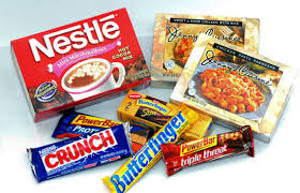 SN) typically seeks to be first or second in all its businesses, yet isn’t even close in the U.S. chocolate candy market, where the Swiss company is dwarfed by Mars Inc. and Hershey Co. When No. 3 Lindt & Spruengli AG (LISN) completes its planned purchase of Russell Stover Candies Inc., Nestlé will fall even deeper into fourth place.
SN) typically seeks to be first or second in all its businesses, yet isn’t even close in the U.S. chocolate candy market, where the Swiss company is dwarfed by Mars Inc. and Hershey Co. When No. 3 Lindt & Spruengli AG (LISN) completes its planned purchase of Russell Stover Candies Inc., Nestlé will fall even deeper into fourth place.Mars and Hershey together control 65 percent of U.S. chocolate sales, researcher Euromonitor estimates, versus 5.2 percent for Lindt and 4.8 percent for Nestle. The combined spending on U.S. television advertising by Mars and Hershey is roughly equivalent to Nestlé’s total American chocolate revenue, the Swiss company says.
To drum up sales in the $18 billion market, the world’s largest food company has added limited-edition Girl Scout Crunch bars and Skinny Cow reduced-calorie chocolate. That’s not enough to really challenge the leaders, said Urs Beck, a fund manager at EFG Asset Management in Zurich. The most obvious countermove, he said: Buy Lindt.
In U.S. chocolate, Nestle “needs to play harder and smarter as an underdog,” Beck said. “Otherwise, exiting the market is an option worth thinking about.”
While Nestlé is far bigger than the American market leaders, it’s unlikely to buy either. Mars is private and has long said it’s not for sale, and Nestlé shareholders would balk at a Hershey purchase because it wouldn’t be a good fit with the company’s push into higher-end, healthier products, Beck said.
Desperate Situation
Lindt Chief Executive Officer Ernst Tanner said July 14 that the company intends to stay independent. Nestle declined to comment on whether it has ever considered buying Stover or Lindt, but executives have long said the company aims to be No. 1 or No. 2 in the categories and markets it operates in.
Nestlé, based in Vevey, Switzerland, considered exiting U.S. confectionery about six or seven years ago, when the category was “desperate,” Nestlé USA CEO Paul Grimwood said at an investor conference last month in Boston. Instead, Nestle is focusing on key brands, and may pursue acquisitions and joint ventures, he said.
After Lindt’s purchase of Stover, announced July 14, the company will have 7.4 percent of the U.S. chocolate confection market, mostly at the high end. That’s what Nestle should focus on in the U.S., said Gillian Hollenstein, chief investment officer at Labha Investment Advisors SA in Zurich.
Saturated Chocolate
“Growing in the U.S. chocolate mass market will be quite a challenge for Nestlé because it’s so saturated,” Hollenstein said. “Lindt has focused on the premium segment and invested in it for years. Nestlé is way behind.”
Nestlé is handicapped because Hershey has the American rights to KitKat, the Swiss company’s largest chocolate brand. Nestle’s main chocolate labels in the U.S., Butterfinger and Crunch, come in at 12th and 26th place among chocolate confectionery, according to Euromonitor. KitKat is No. 4, with 4.3 percent of the market.
Nestlé could move upmarket with its Cailler label, said Jon Cox, an analyst at Kepler Cheuvreux in Zurich. The two-century-old Swiss chocolatier, which Nestle bought in 1929, is credited with inventing milk chocolate. That pedigree makes it a natural vehicle for a push into the high-end.
“I’m amazed it hasn’t been able to leverage its premium Cailler brand internationally,” Cox said.
Nestlé is trying. The company has started selling Cailler online and is working to expand the brand, but it has no official distribution in the U.S., so sales there are minimal.
Intimate Frustration
Developing Cailler will be a “long-term journey,” Nestlé Chief Executive Officer Paul Bulcke told investors in Boston last month. Premium chocolate is “my small, intimate frustration,” he said.
In the U.S. mass market, Nestlé has tried to boost its standing with the introduction of Butterfinger Peanut Butter Cups. The product doubled Butterfinger’s market share during February after being featured in the Swiss company’s first Super Bowl ad. Nestle is also trying to increase sales during the summer, the industry’s quietest period, with mint, peanut-butter and coconut-flavor Girl Scout Crunch bars.
“It’s a clever way of cross-branding, where Nestlé can leverage the brand equity of Girl Scouts,” said Euromonitor analyst Lianne van den Bos. “I can see it work.”
Nestlé shares were unchanged at 69.15 Swiss francs at 9:51 a.m. in Zurich.
Trung-Tin Nguyen, a hedge-fund manager at Trimax Capital AG in Zurich, suggests that Nestlé not worry about the U.S., where it’s “an also-ran,” and concentrate on emerging markets instead.
“They can leave their U.S. business as-is for the moment and should keep open the option of abandoning it,” Nguyen said. Asia is “a bigger, untapped market and there are no big natural, local competitors.”





